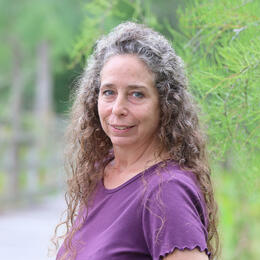Throughout most of the 1900s, Audubon's Corkscrew Swamp Sanctuary in Southwest Florida hosted the largest Wood Stork colony in the U.S. The birds' annual nesting pattern has evolved to align their high energy needs (when they are nesting and raising young) with annual dry conditions when fish are plentiful. By the end of nesting season, adults rely on lower water levels that concentrate fish and other prey in shallow wetlands and within reach of their snapping bills. Wood Stork chicks must fledge before the onset of the summer rainy season to be successful because when the wetlands refill, prey fish spread out across the landscape.
In recent decades, however, over-drainage of the Sanctuary has given small fish less time to grow and reproduce. Plus, native-nuisance, woody shrubs have replaced grasses and sedges across hundreds of acres of marshes and wet prairie at the Sanctuary, reducing the birds’ access to fish. Audubon’s Wood Stork survey data show a steady decline in nesting effort since the 1970s. In fact, over the past several years, Wood Storks have failed to nest at all in the Sanctuary in most years.
Audubon scientists in Southwest Florida have monitored water levels for 67 years. Their data show drier conditions overall and lower water levels in both the wet and dry season. Importantly, the water doesn't last long enough on the landscape in the dry season to support Wood Stork nesting. Their research confirms that canals improved in the early 2000s to relieve regional flood concerns are now overdraining natural areas like the Sanctuary.
It doesn’t take a scientist to see some obvious signs of these changes; for example, roadside swales quickly drain in summer.
While the total amount of rainfall recorded at the Sanctuary each year is relatively constant, a changing climate could alter the timing. If regular downpours are replaced by more rain in fewer events, with more dry conditions in between, this could dramatically impact the environment. With more development occurring in places where water used to be able to move across the land, flooding is still a concern for many neighborhoods, especially during these heavy rainfall events.
In addition to undertaking a largescale effort at the Sanctuary to restore native marsh plant communities where nuisance shrubs have moved in, Audubon has partnered with the South Florida Water Management District to get the water right on a regional scale in the Corkscrew watershed. In the dry season, that means protecting wetland resources from overdrainage, while wet season efforts focus on holding water in our wetlands while keeping roads and homes dry. Working with regional stakeholders, District and Audubon scientists are developing tools to improve decision- making, evaluate restoration alternatives, and gauge restoration progress.
Extreme Weather Events Reduce Nesting Success
At the start of the 2024 breeding season, an unusually rainy winter (courtesy of El Niño) resulted in elevated water levels across Southwest Florida and likely discouraged wading birds from nesting at the historic Corkscrew colony. Wood Storks did start nesting in other Southwest Florida locations much later than usual (February-March instead of December-January). During the May 6 Wood Stork survey, Sanctuary staff saw a large number of nests with adults still incubating eggs. In year of normal rainfall, such late nesting efforts would likely fail as the arrival of rainy season dispersed prey concentrated in dry season pools.
This article first appeared in the Summer edition of the Naturalist. To read the full magazine, click here.





